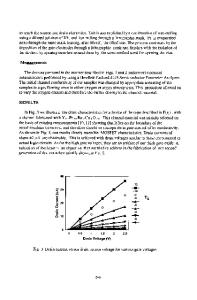Buried Oxide Channel Field Effect Transistor
- PDF / 1,342,859 Bytes
- 7 Pages / 391.5 x 607.5 pts Page_size
- 65 Downloads / 309 Views
Mat. Res. Soc. Symp. Proc. Vol. 623 © 2000 Materials Research Society
groups [ 12-15]. The structures are almost identical in most cases, however, the details differ as do the experimental conditions and the goals. The most important contrast is that all the data shown in this paper and in references [2,4,5] are obtained in room temperatureoperation. In the superconducting FET proposals, the goal was to induce (or inhibit) superconductivity in a channel by modulating the carrier concentration with a gate potential. Our work concentrates exclusively on the normal state properties of the cuprate films. DEVICE ARCHITECTURE An OxFET with the channel material on the surface of the device was recently demonstrated at IBM in which the channel material was YlxPrxBa 2Cu 307-6 (YPBCO).[2] The devices which were demonstrated had a simple architecture illustrated in figure 1 which was chosen for ease of fabrication. In this structure all the materials fabrication is done via pulsed laser deposition (PLD) directly on an unpatterned substrate and the source and drain contacts are directly deposited on the films through a stencil mask. The substrate in this case is niobium doped strontium titanate (Nb:STO) which is a conducting material. The substrate therefore also acted as the gate electrode. The gate dielectric (STO) is deposited on the substrate first, and then the channel material (YPBCO) was deposited. The surface channel FET had characteristic curves similar to conventional silicon MOSFET curves with a transconductance of - 2/uS at a drain voltage of 1 volt and a gate voltage of 10 volts. ON/OFF ratios of up to 10' were observed. However, despite the ease of fabrication of the surface channel devices there are several disadvantages to the surface channel architecture.
IlI (a)
Top
view
METAL
Isolation Trench
u
CuprataeO S TO0 Nb:STO aubstrate (b) Side
view
Figure 1: Surface channel architecture (a) top view (b) side view. In the surface channel devices, the substrate also serves as the gate electrode. Therefore, there is a very large capacitance associated with the gate and there is a strong coupling capacitance to other devices. This makes operation at high frequencies impossible. Another significant disadvantage of the surface channel architecture is a result of moisture sensitivity of the cuprate materials as a class. Since the cuprate is an unshielded top layer, it slowly deteriorates due to water contamination, making necessary the deposition of thick cuprate films to protect the switching layer near the gate oxide/channel interface. However, the source and drain electrodes are only in direct contact with the upper (unswitched) part of the cuprate film. Thus the surface 4
channel architecture has two limiting problems: First, there is a potential resistance (in series with the channel) which could limit the "ON" state performance of the device due to conduction through unswitched cuprate layers from the source and drain electrodes to the switched part of the cuprate channel near the gate oxide/channel inte
Data Loading...











